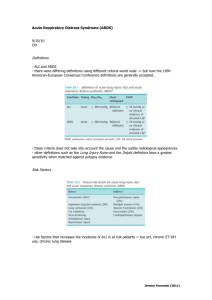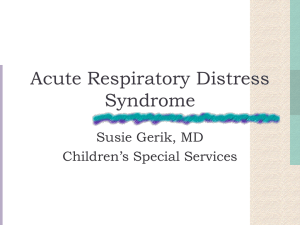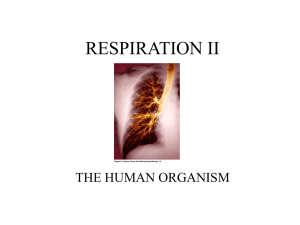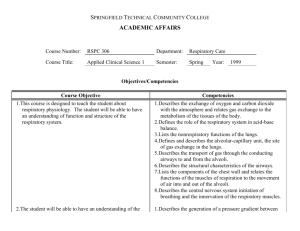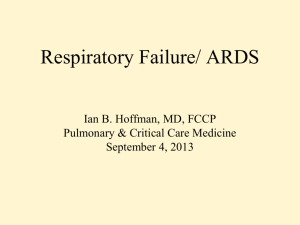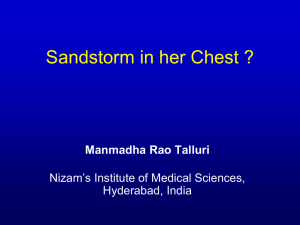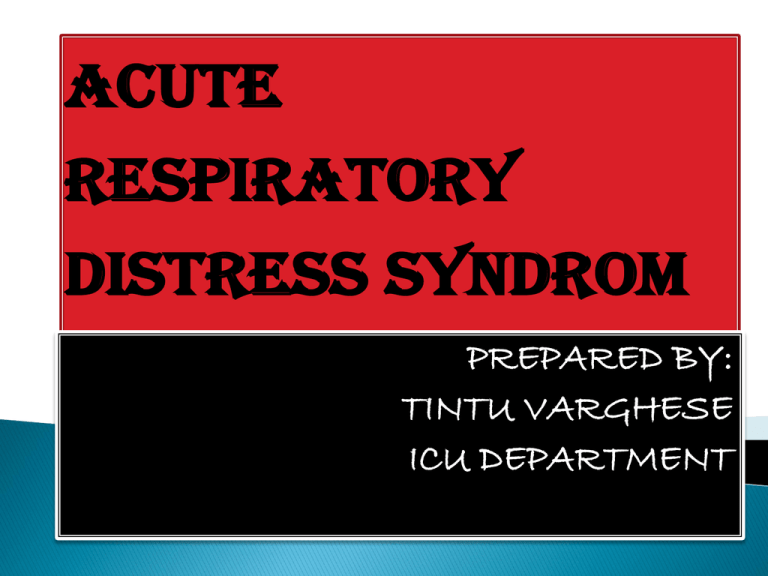
ACUTE
RESPIRATORY
DISTRESS SYNDROM
PREPARED BY:
TINTU VARGHESE
ICU DEPARTMENT
CASE
NO: 195937
NAME: XYZ
AGE:25YRS
SEX: MALE
DIAGNOSIS:
ACUTE
RESPIRATORY DISTRESS
SYNDROM, SEPTECEMIA
DOA:05/02/2013
The patient is 25 years of age, male,
approximately weighs 80kg
He is unconscious with ET tube with
ventilator support and patient is
sedated. GCS3/15,with the following
vital signs.
BP=130/80,
PR=70bpm,
RR=24mts
Temp= 38.2,
SPO2= 93%
SKIN
HEAD
Patient
unconscious
On fully sedation
On ventilator
EYES
EARS
No
unusual
discharge
No tenderness in
sinus
MOUTH
NECK AND THROAT
CHEST AND LUNGS
HEART
ABDOMEN
GENITALS
Pulse
full and
equal
No lesions noted
No
past medical
history
25yres male patient came in ER with
complaints of tachypnea, agitated, SOB,
fever, productive cough which was started
one week ago and became worse. From
ER patient was confused, SPO2 was low
85%,CXR showed patchy opacities are seen
in the middle and lower zone of both lung .
Hilar shadows and vascular markings are
prominent in both lungs. Mild to moderate
pleural effusion in both lungs
Patient was shifted to surgery ward,
patient was desaturated and developed
tachypnea and shifted to ICU for
further treatment and observation.
Patient was intubated and on
ventilator and fully sedated .patient
developed hypotension and started
inotropic support for two days. After all
management patient was extubated
and fully conscious and oriented.
Patient shifted to surgery ward.
DRUG
DOSE
ROUTE
ACTION
INJ. COLOMYCIN
1MILLION
IV
INJ.TAVANIC
750MG
IV
INJ. MEROPENEM
1GM
IV
INJ. NEXIUM
40MG
IV
ANTIBIOTICS(generat
ion3cephalosporin)
ANTIBIOTICS
(generation2
fluoroquinilone)
ANTIBIIOTICS(generation
3 cephalosporines)
H2RECEPTOR
INJ. PERFALGAN
1GM
IV
ANTIPYRETICS
TAB TAMIFLUE
75MG
NGT
ANTIVIRAL
TEST
WBC
PATIENT VALUE NORMAL
VALUES
42.25%
4.23-9.07%
HGB
13.2(G/DL)
13.7-17.5(G/DL)
PLT
346(10^3/UL)
163-337(10^3/UL)
UREA
8.7mmol/L
1.8-8.3 mmol/L
CREATININE
113.7 mmol/L
58-110 mmol/L
SODIUM
142 mmol/L
135-150 mmol/L
POTTASIUM 3.8 mmol/L
3.5-5 mmol/L
PT
13.6SEC
INR
1.31%
10.9 TO 16.3
SEC
2 -4%
APTT
29.6SEC
27-39SEC
PH
7.13
7.35-7.45
PO2
88.8
80-100
PCO2
58.5
35-45
CHCO3
19.4 mmol/L
22-26 mmol/L
Patchy
( air space) opacities are
seen in the middle and lower
zone of the both lungs.
Hilar shadows and vascular
markings are prominent in both
lungs.
Mild to moderate plural effusion
in both lungs.
BIilateral
pleral
effusion ( large
amount)with opacity
is seen in lower area
of both lungs
A distinct type of hypoxemic respiratory
failure characterized by acute abnormality
of both lungs was first recognized during
the 1960s. Military clinicians working in
surgical hospitals in Vietnam called it
shock. Then referred to it as adult
respiratory distress syndrome . Subsequent
recognition that individuals of any age
could be afflicted led to the current term,
acute respiratory distress syndrome (ARDS).
ARDS is an acute, diffuse,
inflammatory lung injury that leads to
increased pulmonary vascular
permeability, increased lung weight,
and a loss of aerated tissue . Clinical
hallmarks of ARDS are hypoxemia and
bilateral radiographic opacities, while
the pathological hallmark is diffuse
alveolar damage (ie, alveolar edema
with or without focal hemorrhage,
acute inflammation of the alveolar
walls, and hyaline membranes).
Acute respiratory distress syndrome
(ARDS) is a sudden and progressive
form of acute respiratory failure in
which the alveolar capillary membrane
becomes damaged and more
permeable to intravascular fluid
resulting in severe dyspnea,
hypoxemia and diffuse pulmonary
infiltrates.
superior lobe
inferior lobe
Direct
Lung Injury
◦Common causes
Aspiration of gastric
contents or other
substances.
Viral/bacterial pneumonia
Chest trauma
Embolism: fat, air, amniotic
fluid
Inhalation of toxic substances
Near-drowning
O2 toxicity
Radiation pneumonitis
◦Common causes
Sepsis
Severe traumatic
injury
◦ Less common causes
Acute pancreatitis
Anaphylaxis
Prolonged Cardiopulmonary bypass
surgery
Disseminated intravascular coagulation
Multiple blood transfusions
Narcotic drug overdose (e.g., heroin)
Non pulmonary systemic diseases
restlessness
Dyspnea
Low blood pressure
Confusion
Extreme tiredness
Change in patient’s behavior
Mood swing
Disorientation
Change in LOC
◦ If pneumonia is causing ARDS then client may have
Cough
Fever
◦
◦
◦
◦
◦
◦
Shortness of breath.
Tachycardia
Cyanosis (blue skin, lips and nails)
Think frothy sputum
Metabolic acidosis
Abnormal breath sounds, like crackles
Increased PaCo2 with respiratory alkalosis.
Severe difficulty in breathing i.e., labored,
rapid breathing.
◦ Decreased PaO2
◦
◦
◦
◦
◦
◦
◦
◦
Lung injury
Release of Vasoactive substances
(serotonin, histamine, bradykinin)
Damaged Type II alveolar cell
Surfactant production
Alveolocapillary
membrane
permeability
Alveolar
Compliance and recoil
Vascular
narrowing &
obstruction
Bronchoconstriction
Outward migration of
blood cells & fluids
from capillaries
Atelectasis
Hyaline membrane
formation
Pulmonary Edema
Lung compliance
Impairment in
gas exchange
ARDS
Pulmonary
hypertension
24 hours vital signs observed will be monitored and documented.
Monitor for exhaustion and signs of reduced lung compliance eg:
use of accessory muscles for respiration.
Evaluate effectiveness of respiratory function like rate, rhythm and
depth.
Suction airway hourly or as necessary to remove secretion.
Administer prescribed inhalations or bronchodilators mucolytic as
ordered.
Institute safety of the patient.
Fall prevention.
Side rails up
low bed position.
Prevent infection and potential complication.
Provide patient and family education about treatment and recovery
of the patient.
Persons with ARDS are hospitalized
and require treatment in an intensive
care unit.
No specific therapy for ARDS exists.
Supportive measures :
◦ Supplemental oxygen
◦ Mechanical respirator
◦ Positioning strategies .
–Fluid
Administration – The patient should be
aggressively fluid resuscitated for any signs
/symptoms of shock in order to optimize end
organ perfusion. Once hemodynamic stability is
achieved, fluid administration should be
minimized to decrease the alveolar-capillary leak
and pulmonary edema. Aggressive diuresis
should also be considered once hemodynamic
stability is achieved. Nutritional support should
be initiated as early as possible.–
.Prone Positioning – Has been used since mid
1970’s in an effort to improve lung perfusion
and oxygenation. Prone position or bed that
provides continuous lateral position helps
mobilize pulmonary secretions and improve
ventilation/ perfusion matching. In prone
position patient face down improves ventilation
in posterior lung, where edema settles when
patient in supine position . Risks are mainly
logistical, i.e. dislodgement of endotracheal
tube or vascular lines, increased intraabdominal pressure, feeding intolerance, and
edema (facial). The greatest effects are
achieved when patients are maintained prone
for 12 hours or longer and oxygenation
improves in 60-70% of patients.
◦ Antibiotics
◦ Anti-inflammatory drugs; such as
corticosteroids
◦ Diuretics
◦ Drugs to raise blood pressure
◦ Anti-anxiety
◦ Muscle relaxers
◦ Inhaled drugs (Bronchodilators)
RECRUITMENT MANEUVER
Patients with ARDS require support with mechanical
ventilator.
Utilizing a CPAP mode and providing PEEP 35 to 40
for 40 second.
In ventilator PEEP used to prevent alveolar derecruitment at end-expiration. In patients with ARDS,
PEEP is used primarily to improve arterial
oxygenation. Increased end-expiratory pressure
increases mean airway and intra thoracic pressure.
When applied correctly, this prevents alveolar
collapse, increasing the volume of aerated lung by
preventing alveolar de-recruitment at end-expiration
The beneficial effects of PEEP include
improved total lung compliance, and decrease
in the work of breathing for spontaneously
breathing patients, and improved gas
exchange through a reduction in
intrapulmonary shunting and improved
ventilation–perfusion matching. Improved gas
exchange may allow for reduction in the
fraction of inspired oxygen (FiO2) and oxygen
toxicity. Furthermore, studies have suggested
that PEEP can reduce the release of bioactive
mediators by the lung and may reduce the
incidence of secondary infections in the lungs
Common complications are;
◦ Nosocomial pneumonia:
◦ Barotrauma
◦ Renal failure
Other complications are :
◦ O2 toxicity,
◦ stress ulcers,
◦ Tracheal ulceration,
◦ Blood clots leading to deep vein
thrombosis &
◦ pulmonary embolism.
Ineffective breathing pattern related to decreased
lung compliance, decreased energy as
characterized by dyspnea, abnormal ABGs,
cyanosis & use of accessory muscles
Impaired gas exchange related to diffusion defect
as characterized by hypoxia, & cyanosis.
Risk for decreased Cardiac output related to
positive pressure ventilation.
Impaired physical mobility related to monitoring
devices, mechanical ventilation & medications as
characterized by imposed restrictions of
movement, decreased muscle strength & limited
range of motion.
Knowledge deficit related to health
condition, new equipment &
hospitalization as characterized by
increased frequency of questions posed
by patient and significant others &
immobility.
Ineffective protection related to positive
pressure ventilation, decreased pulmonary
compliance & increased secretions as
characterized by crepitus, altered chest
excursion, abnormal ABGs & restlessness.
Risk for impaired skin integrity related to
prolonged bed rest,
prolonged
intubation
NURSING
DIAGNOSIS
Impaired gas
Objective data:
exchange related
patient is dyspenic to diffusion defect
, restless, cyanosis as characterized
and desaturated.. by hypoxia, &
cyanosis
ASSESSMENT
PLANNING
After 12 hours
of nursing
intervention
patient will
shows signs of
improved
ventilation and
adequate
oxygenation.
IMPLIMENTATION/
RATIONALE
Vital signs,
→Evaluate
breath sounds, the degree
breathing
of
pattern and
compensati
level of
on.
consciousness.
Checked hourly. →To
→Evaluated
evaluate o2
pulse oxymery. saturation.
Shows 95%
→Evaluated
→Facilitate
head of the bed adequate
35 degree.
oxygen
intake
→Suctioned
secretion as
→To clear
needed
the airway
→Administered
bronchodilators,
expectorance
like
syp:.mucolyte,
as orders.
→Blood gas
analysis done 2
hourly .
→To treat
the
underlying
condition.
→To check
the gas
level.
EVALUATION
After 12 hours of
nursing
intervention patient
exhibited signs of
improved
ventilation like free
of distress, ABG
shows Paco2
between 35-45.
Remain
on modified bed rest
Take medication prescribed.
Follow up regularly.
Take adequate nutrition.
Maintain personal hygiene.
Maintain skin care.
Regularly checkup vitals
This is the case of 25 years old male patient with the diagnosis of
acute respiratory syndrome and septicemia. Acute respiratory
distress syndrome (ARDS) is a sudden and progressive form of acute
respiratory failure in which the alveolar capillary membrane becomes
damaged and more permeable to intravascular fluid resulting in
severe dyspnea, hypoxemia and diffuse pulmonary infiltrates.
Criteria which are fulfilled by the patient, conservative management
rendered such as investigations , Antibiotics, Anti-inflammatory
drugs; such as corticosteroids, Diuretics, Drugs to raise blood
pressure, Anti-anxiety Muscle relaxers, Inhaled drugs
(Bronchodilators).. A conservative fluid management strategy has
been shown to reduce duration of mechanical ventilation andICU
stay. Patient was intubated and on ventilator and fully sedated
.patient developed hypotension and started inotropic support for
two days. After all management patient was extubated and fully
conscious and oriented. Patient shifted to surgery ward.
Wikipedia.
Medical and surgical nursing book
volume 1 and 2 of Brunner.
Luck man and Sorensen’s MedicalSurgical Nursing a Physiologic
Approach 4th edition Lippincott
Manual of Nursing Practice 9th edit.
tintu



